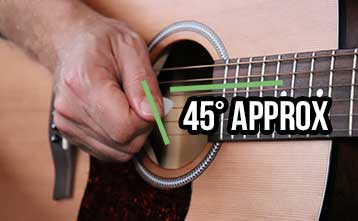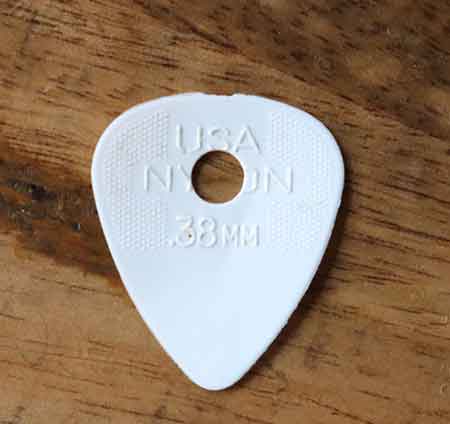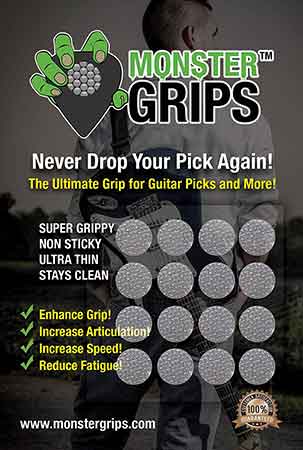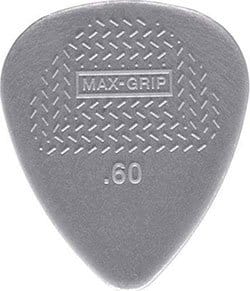In this post we are going to talk about different ways can stop a guitar pick from moving, slipping or being dropped.
This will include tips and techniques to hold your pick ‘correctly’, and methods and products that can help.
As an older beginner guitar player, I have gone through this and wanted to share what I have learned so that you could benefit.
Here are some topics we are going to cover:
- Hold the guitar pick correctly
- Use a relaxed but firm grip
- Choose the correct pick angle
- Keep your hands dry
- Try different pick thicknesses
- Use a non-slip guitar pick
- Use a pick sleeve
So let’s get into it, first, we will cover how to hold the pick and then cover the common issues.
How To To Hold A Guitar Pick Correctly
Firstly let me say that I have read about this topic a great deal and after all the reading can add that many guitarists have their own way of using a guitar pick and that it can and will differ depending on what type of song you are learning, what feels comfortable and what someone may have taught you.
So, for example, if you are playing a song with light strumming versus a song with accented strumming versus a picked song versus a song with a sweeping pick for example then they will all differ in some way.
Just as some of the very best guitarists were never taught and just found their way, many people do the same when discovering the best way to hold a pick without it slipping.
So now that we have got out the way we can discuss initially, what I believe, the most productive way of holding a pick without it slipping or being dropped.
You want to keep the hand as relaxed as possible while also keeping the guitar pick safe and secure.
Start by resting the pick on the first knuckle on the side of your index finger. You should be able to balance it here without it falling to the floor.
Next, I place my thumb over the top of the pick, as you can see in the photo below. For me, this means that I really don’t have much of the pick exposed on the top side. My personal preference is to be able to move the pick around as needed depending on how I’m hitting the strings.
If you want more of the pick exposed, just pull the fingers in toward the palm.
So this is what I consider to be the most productive and secure way of holding a pick and while this is the preferred way by most be aware it’s not the only way.
In addition, holding the guitar is just one part of your overall position setup when learning guitar. There are some other factors to consider and this comes down to hand position and posture. If you want to learn more about and what to avoid doing then we have a fully illustrated guide here Guitar Posture & Hand Position For Beginners
Moving on from this, lets now get into how to fix some common issues.
How Hard / Tight To Hold A Guitar Pick
When learning to play guitar, the pick is often dropped because we hold it too lightly while we strum or pick too hard. In contrast to that, sometimes we grip down so hard or tight on the pick that it makes our arms and wrists tense and rigid, particularly if we are playing a song with lots of picking.
This can make our guitar playing sound forced, unnatural and from my experience can make the whole thing a little less enjoyable.
What we want is a relaxed but firm grip on the pick that can change with the technique or strumming style we are trying to use at any one time.
So for example, if you are playing a light strum guitar song versus a metal solo then you will be using different techniques and different grip strength.
Striking the correct balance with grip strength when you are learning, however, isn’t something that comes naturally, so here a few tips to help you determine how hard to hold a guitar pick.
You don’t have to grip the pick as hard as you think when strumming. A technique you can try is holding the guitar pick as softly as you can without it sliding out of your fingers and dropping to the floor. Try and play really slowly, around 30-40 bpm using a metronome.
When you have got used to that you can try letting go a little more. You may have to do all this in stages but what you are trying to do is create a really loose, relaxed and tension-free grip that still allows you to use the pick properly.
If you think you hold the guitar too lightly then the amount of pressure and grip strength you should exert is similar to that of holding a pen. You don’t hold it so loose that you are unable to write with it but you also don’t press your finger into the pen.
It could be your angle of attack. Often what we think is to do with how hard we hold the pick is actually more about the angle of attack.

If you need to hold the pick tightly to prevent losing it, then you are likely doing something wrong, more than likely your attack angle is too flat or you are hitting the strings way, way too hard.
You should hold the pick at an angle to around 45 degrees and kind of brush the string rather than aggressively pluck it.
You can also get a lot of dynamic control by adjusting your grip strength on the pick. Holding a pick very firmly without it moving at all will mean louder notes, holding a softer will mean softer notes.
The same can be said for pick thicknesses. If you choose to use a heavy pick (0.8 to 1.2) to do some dynamic strumming then it may prove to be the wrong choice. It could end up sounding louder than intended and you will likely have to exert a lot more control than if you used a light to medium gauge pick
Experimenting with different pick thicknesses and how hard you hold the pick will help you develop an understanding of how it affects tone, dynamic control and help you with tension.
Tension from holding a guitar pick too tightly over and over again, however, can lead to repetitive strain injury and these symptoms can last for long periods of time and prevent you from enjoying playing guitar.
If you find yourself experiencing an issue like this then and want to learn how to stop this injury from occurring we have a complete illustrated stretching guide written by Senior Physiotherapist, Jeff Caulfield which covers carpal tunnel syndrome, cubital tunnel syndrome, tennis elbow and trigger finger to name a few. You can read it here Best Stretching Exercises For Guitar Players – Illustrated Guide (Back, Neck, Hand, Elbow, Fingers)
So those are a few tips that you can implement but it is worth understanding that as you develop your guitar playing, knowing about grip strength can really level up your playing.
How To Make Guitar Picks Sticky
So your guitar pick moves around when you play or falls out of your hand and you are looking for something to make them more sticky or more grippy.
The first and more obvious one to consider is how sweaty or wet your hands may be. So always wipe down your hands with a clean cloth before and/or while playing.
If you are looking for some home solutions to try out, then here are some quick and cheap options you can try. They aren’t the most elegant but can work.
Double-Sided Tape On The Guitar Pick
The first option you have is to use double-sided sticky tape. Stick it to the side of the pick facing the ground and then stick this to the bottom finger that holds the pick. In the photos below this would be my index finger.
This will then ensure that the pick stays in place and will also enable you to tuck the pick under your thumb if you wish to fingerpick or tap during a song for example.
Obviously this would require you removing and replacing the tape often but is a cheap and quick solution.
As a paid alternative to this, you could try Monster Grips (click here to see on Amazon), which are grippy stick pads that you can stick to your guitar pick on either side.
Scoring and Sanding The Guitar Pick
A useful and quick way to create some grip on a guitar pick is to roughen it up using some sandpaper or a craft knife to cross-hatch the surface.
If sanding, use a high grit piece of sandpaper you can rub down the flat surface of either side of the pick.
This will then give you a surface that will provide some resistance to movement so that your fingers can cling to it.
Punching Holes In The Guitar Pick

Using a thumbtack you can punch holes in the middle of the guitar pick in any pattern you desire. Best to try and match the shape of your thumb or finger depending on what you use to strum.
This then acts as an area where your fingers can catch on the hole and in turn provides resistance so results in a better grip. This can be done to any pick so it is a great option if you have some cheap picks or some that you have avoided using as they slip too much.

You can also try using a regular hole punch on thinner picks, which is what I tend to do. Just line it up under the hole punch as you would do with some paper or card.
The edges of the hole enable your thumb or finger to catch and in turn, this provides an additional level of grip.
Best Non-Slip Guitar Picks
As an alternative to home solutions or modifications to an existing pick, there are picks that have been made specifically to provide more grip while playing the guitar.
Dunlop Max Grip – Best Non-Slip Pick For Acoustic Guitar
A well-known brand, one you can trust and an excellent molded grip on the surface so you can maintain control. Excellent for beginner guitar players.
Work great on both acoustic and electric. These come in different thicknesses, click here to check the Dunlop Max Grip picks out on Amazon.
Ibanez Sand Picks – Best Non-Slip Guitar Pick For Metal
No introduction required for Ibanez and these picks use light grit sandpaper stuck to the guitar pick to add grip.
They come in different thicknesses, click here to check the Ibanez Sand Grip out on Amazon.
Dava 6024 Grip Tip – Best Non-Slip Pick For Electric Guitar
A molded rubber grip that is bonded to the pick provides an excellent grip. They are approximately 1mm thick
It can be used on acoustic but sounds a little ‘darker’ or ‘heavier’. Best for lead electric guitar. Click here to check the Dava 6024 on Amazon
The thing with picks is that there is no ‘one size fits all’ and part of the guitar journey is figuring out what works for you.
However, if you have found the pick for you or just want a solution that can transfer to any pick without any of the time or faffing around required for a home solution then the best method I have found is using a guitar pick sleeve.
The Pick Ninja (Pick Sleeve) – Best Overall Non Slip Pick Option
I have tried the majority of the products and tricks listed above and they all work to some degree. Personally I felt that the home solutions weren’t long term solutions, the different types of picks are cool but you are then limiting yourself to those types of picks only.
As someone who likes to experiment and find what works for me then this wasn’t the solution I was looking for. I wanted to be able to use whatever I pick I wanted to whilst also having something that had a good level of grip and comfort and wasn’t going to split easily.
Another product that I was recently introduced to was a guitar pick sleeve called The Pick Ninja, they are not bonded to a pick and so they can be used with all picks, feel quite thick and substantial in your hand, have great grip and they are concave in shape so sit naturally between your finger and thumb. They have been the best option I have tried to date. You can get The Pick Ninja’s in a pack here on Amazon
I talk about the Pick Ninja in this time-stamped video below.
For me, they provide confidence when both strumming and picking and I no longer have a pick that slips around in my fingers. When you first start using them they feel a bit ‘odd’ because they are a lot thicker than the average pick, but use them for 10 to 15 minutes and you soon get used to them.
You can also have two picks in them if you wish but to do this you will need one narrower pick. You can flip around the pick sleeve in an instant have access to a different thickness and material pick. A great way to change dynamics during a song or set.
If you have any tips, tricks or experiences with other picks that have helped you with pick slippage, rotation or stopped them from being dropped then let me know in the comments below.






